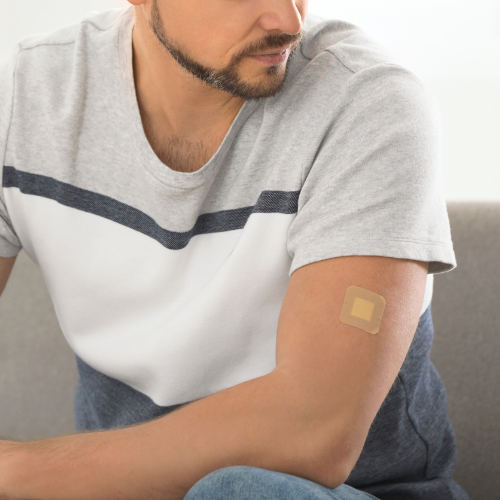
Treatment Options to Quit Smoking
Nicotine gum, patches, therapeutic vapes, prescription medications or counselling, quitting smoking for good is possible with a range of treatment options.

First-line nicotine replacement therapy
Nicotine patches:
Patches can be bought with or without a prescription. This form of NRT gives a measured dose of nicotine through the skin so that you can wean off nicotine by switching to lower-dose patches over the course of weeks.
Nicotine gums:
Nicotine gum is a fast-acting form of replacement that can be bought without a prescription at local pharmacies or supermarkets. While looking like regular gums, they are not used in the same way. Instead, after the initial chewing, the gum is parked under the tongue (or between your gum and cheek) until the tingling stops before you start chewing again. The nicotine released by the gum is absorbed through the mucous membrane of the mouth.
Nicotine lozenges:
Unlike gums, lozenges are taken when the craving occurs and rolls around the mouth until they dissolve. The nicotine is absorbed through the mouth and slowly released into your body, helping manage cravings.

Nicotine vaping products
Vaping is considered a second-line treatment for quitting smoking, meaning it is only encouraged when other cessation methods have failed. By mimicking some of the cigarettes' behavioural, social, and pharmacological aspects, vaping represents a new treatment for cigarette addiction.
From 1 January 2024, all nicotine vaping products, such as e-cigarettes, pods and liquid nicotine, are classified as prescription medicines and therefore only obtainable with a prescription.
While there are still few studies regarding possible longer-term effects of vaping, experts generally agree that e-cigarettes are considerably less harmful than smoking, even though they are not entirely risk-free. Patients must meet eligibility requirements in order to access Nicotine Vaping Products.

Prescription-only treatments
Pharmacotherapy:
First-line pharmacotherapies for smoking cessation include nicotine replacement therapy (NRT) and Non-nicotinic pharmacological therapy. For most people, treatment choice is based on patient preference, with some exceptions for patients with contraindications to certain drugs. Non-nicotine medications act by reducing the cravings for nicotine and help with the withdrawal symptoms former smokers get when first quitting smoking. In Australia, there are currently two medications available to help people quit smoking: Champix® (brand name for Varenicline tartrate) and Zyban® (brand name for bupropion).
Nicotine nasal spray:
Nicotine nasal spray is only available by prescription. This NRT has a rapid action as it delivers nicotine absorbed through the nose directly into the bloodstream. It relieves withdrawal symptoms quickly and helps control your nicotine cravings.
Nicotine inhalers:
The nicotine inhaler is a thin plastic tube with a nicotine cartridge inside. Unlike other inhalers, which deliver most of the medicine to the lungs, the nicotine inhaler has most of the nicotine absorbed into the bloodstream through the mouth and throat. Nicotine inhalers are the FDA-approved nicotine replacement method with a similar feel to smoking a cigarette, which some people trying to quit find helpful.

Holistic approaches to quitting
Counselling:
Some smokers may benefit from speaking with a professional counsellor or psychologist about their smoking to understand how it impacts their lives. It is often a good idea to seek counselling before quitting.
Hypnotherapy:
Hypnosis involves an altered state of awareness in which you appear to be asleep or in a trance. Hypnotherapy for smoking cessation often involves asking a patient to imagine unpleasant outcomes from smoking. There is mixed evidence to support hypnosis' use for smoking cessation. It is therefore recommended that you seek advice before beginning hypnotherapy.
Acupuncture:
When treating certain conditions with acupuncture, specific areas of the body are argeted. Smokers' cravings are suppressed most effectively when pressure points in the ears are applied.
For more information about how to quit smoking, please visit Quit and the Australian Tobacco Harm Reduction Association for additional resources.
